History of Victorian Costume and Social Change.
Thursday 14th March 2019 by Barbera Joyce on "100 Years of Costume Drama.How clothes reflect social change in the 19th century".
On Thursday evening the 14th of March 2019 members and one visitor enjoyed a vivid description of the change in costume of men and women during the Victorian era. The talk was illustrated by images of clothes from the various decades of the Victorian period.

source unknown ex Wikipedia commons public domain Victorian Fashions.
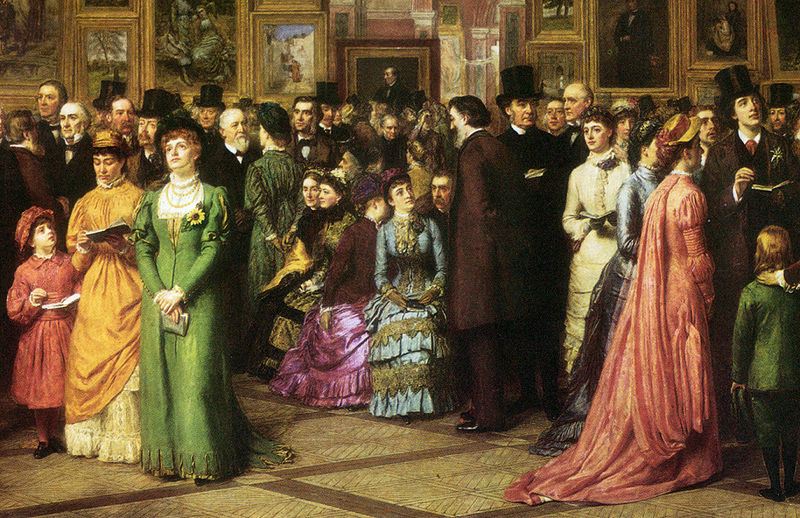
Ex Wikipedia: [Picture is currently in a private collection] A Private View at the Royal Academy, 1881 is a painting by the English artist William Powell Frith exhibited at the Royal Academy of Arts in London in 1883. It depicts a group of distinguished Victorians visiting the Royal Academy Summer Exhibition in 1881, just after the death of the Prime Minister Benjamin Disraeli, whose portrait by John Everett Millais was included on a screen at the special request of Queen Victoria (visible in the archway at the back of the room). The room is Gallery III, the largest and most imposing room at Burlington House.
Frith worked on the painting through much of 1881 and 1882. He later said in My Autobiography and Reminiscences, published in 1887, that "Beyond the desire of recording for posterity the aesthetic craze as regards dress, I wished to hit the folly of listening to self-elected critics in matters of taste, whether in dress or art. I therefore planned a group, consisting of a well-known apostle of the beautiful, with a herd of eager worshippers surrounding him."
The subject of the painting is the contrast between lasting historical achievements and ephemeral fads. The portrait of Disraeli represents the former, and the influence of the Aesthetic movement in dress represents the latter. Aesthetic dress is exemplified by the principal female figures, to the left, in green, pink and orange clothing. Oscar Wilde, one of the main proponents of Aestheticism, is depicted at the right behind the boy in the green suit, with signature lily buttonhole, surrounded by female admirers.
Social Status.
The speaker noted how the illustrations and recorded descriptions of people’s clothes were very much indicators of social status. The wealthy could afford to have clothes made for ordinary use and for display and could preserve them or hand them down to others. Therefore surviving clothing is mainly from the wealthy whose clothes were not subject to rough work or wear.
Society was stratified and the clothes of the wealthy group changed with fashion and influenced the other classes trying to emulate them in dress. As display symbols of wealth some types of clothing needed extreme care and maintenance to ‘keep their looks’.
The subject of clothing in that era has considerable documentation and many available studies and websites devoted to it, and so the speaker talked mainly about the wealthier class.

An 1837 dress showing the tight waste and corsetting.
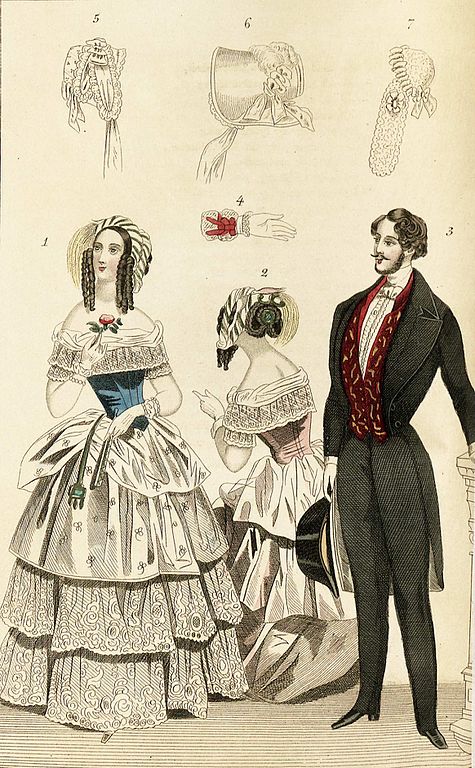
1844 fashion plate depicting fashionable clothing for men and women.
Fasion plate girls 1870 French Magazine

1861 Victorian mens costumes plate 1
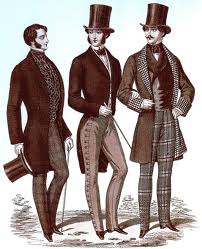
Victorian mens costumes plate 2. Top Hats were an expensive item and required hours of maintenance.
Change in cost and method.
At the start of the Victorian era most clothes were hand made and hand cut and sewn. As the period developed the fruits of the industrial revolution and the availability of cotton made great changes. The sewing machine altered both household ability to make clothes and in industrial factories led to mass market cheaper clothing.
Cotton thread and the sewing machine revolutionised clothing manufacture.
Clothes were changed many times per day by the wealthy and the up and coming middle classes who could afford to emulate them. Morning dress, day dress and evening dress developed with subsets of evening dress for ladies depending on the event to which people were going.
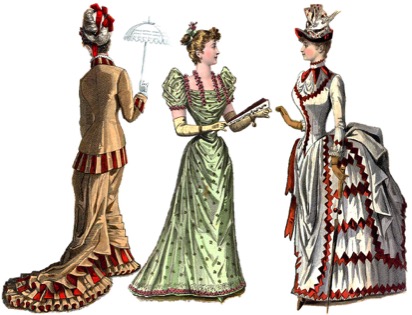
1880s Evening Dress. Dresses Cut low for some events but high for others. Do not make a mistake about the rules!

A comment on dress which shows both the pose, and the middle class children's holiday dress.
Second hand market and business. A very large industry.
As wealth and leisure dictated the higher fashions, after use or when unfashionable these clothes were disposed of to the second hand market or distributed to servants who wore or changed the clothes to suit their purposes. The business of making new clothes ran alongside a much larger trade in altering and selling second hand, or third hand or fourth or fifth hand clothing.
As long as it was still wearable there was a market for it. Such large usually unlicensed or irregular markets also gave cover for more dubious or criminal activity in some parts, with some dealers handling both legitimate clothing and other illegal business. The ‘Petticoat Lane’ market in London existed from its ‘Hog Lane’ Tudor name to ‘Petticoat Lane’ in early Victorian times but changed its name to ‘Middlesex Street’ in the 1830s and only became a licensed formal market place in 1930.
Social change.
As the wealthy displayed, and changed fashion it was then as now, important for some people to ‘keep up with your peers’ in display matters, and changes occurred and worked down though the emerging middle class and by the second hand market route was seen later on the poor, although altered to suit their daily use.
The increasing cash available to the middle and working classes changed the range and availability of clothes and footwear from the beginning of the Victorian era to its end, and industry developed mass market clothes to sell to them.
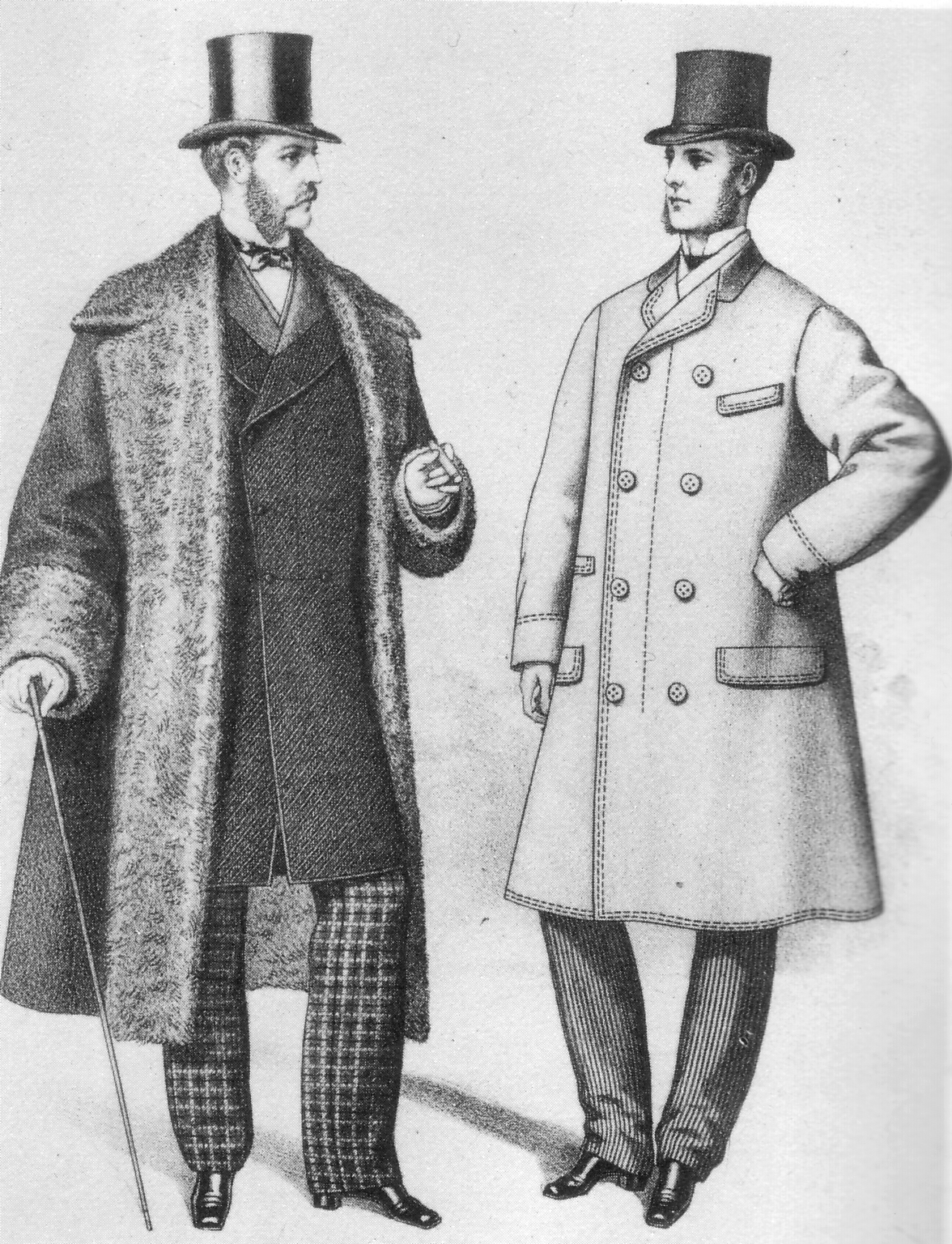
PublicDomain Overcoat left and topcoat right from The Gazette of Fashion 1872 5 187 Mens Coats 1872 Fashion Plate
Crinoline and mass manufacture.
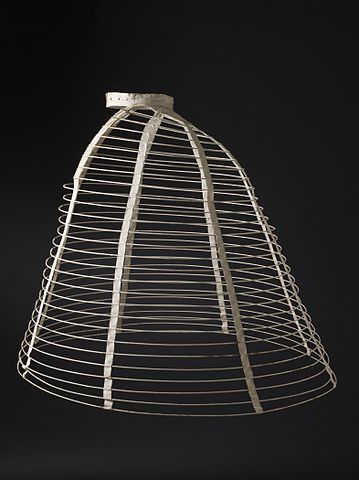
From USA, LA County Museum Of Art Woman's Cage Crinoline LACMA M2007211380
Refer: https://en.wikipedia.org/wiki/Crinoline
With the replacement of many layers of petticoats by a ‘crinoline’ support frame, ladies were able to walk unhampered by the heavy weight of many cloth or horse hair stiffened petticoats but sitting down could lead to lower body display unless the crinoline was correctly folded for modesty. Thus arose the undergarment knickers industry for ladies who previously had not worn such undergarments.
This became a large manufacturing industry in many materials with steel forms being easy to manufacture, fold and ship to market.
Image: Woman's Cage Crinoline Image
Description: English:
England, circa 1865
Costumes; underwear (lower body)
Cotton-braid-covered steel, cotton twill and plain-weave double-cloth tape, cane, and metal
Center back length: 36 1/2 in. (92.71 cm); Diameter: 38 1/2 in. (97.79 cm)
Purchased with funds provided by Suzanne A. Saperstein and Michael and Ellen Michelson, with additional funding from the Costume Council, the Edgerton Foundation, Gail and Gerald Oppenheimer, Maureen H. Shapiro, Grace Tsao, and Lenore and Richard Wayne (M.2007.211.380)
Costume and Textiles
Date circa 1865
Collection Los Angeles County Museum of Art
Dying.
The advent of chemical dyes during the mid-Victorian period and ability to ‘print’ on cotton made a change in the range and colour of clothes used by people.
Mourning.
As Victorians had a defined ritual for mourning with many subsets of periods and type of dress, a major proportion of the business of dyers was the dying of existing formal clothes black for those who could not afford ‘new mourning clothes.
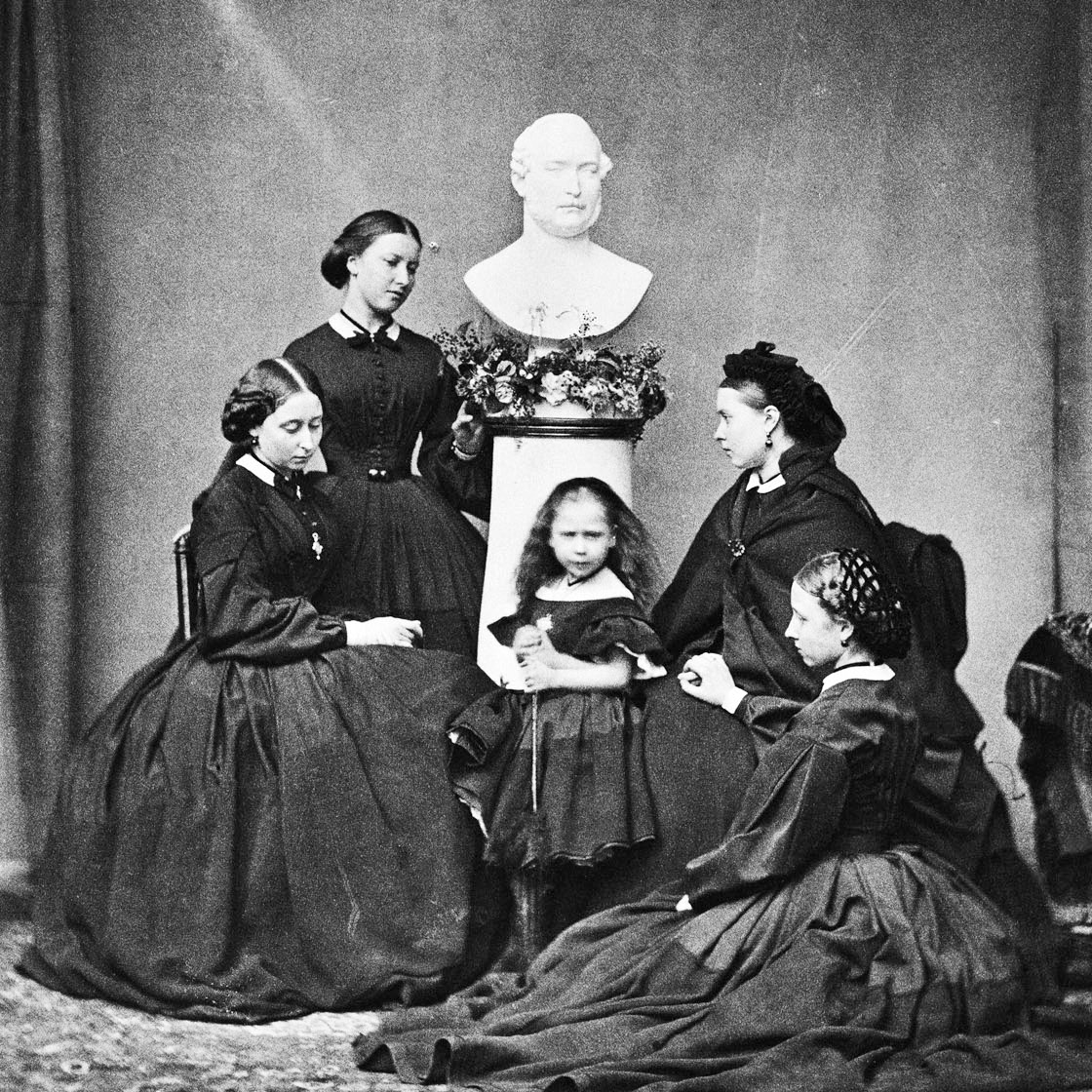
Public Domain Princess Beatrice mourning
Workers.
From Durham university website for schools.
https://community.dur.ac.uk/4schools.resources/victoriandurham/home8.html
What did the poor wear?
Poor families owned a very few everyday outfits and, if they were lucky, some smarter clothes to wear to church or on special occasions. Many outfits were bought second-hand and were passed down through the family. Clothes would have been mended and patched for as long as possible.
Clothes had to be practical. You had to be able to work in them and they had to last a long time. They were often made from wool or cotton in dark colours as this was cheaper and the dirt didn't show as much. Shoes also had to last a long time. Some people wore heavy boots with thick hob-nailed soles. Women wore caps and bonnets not just to be respectable but to keep hair from getting caught in machines and to fend off dirt and head lice.
Children wore clothes handed down from older family members. Not all families could afford shoes for their children so some had to go barefoot.
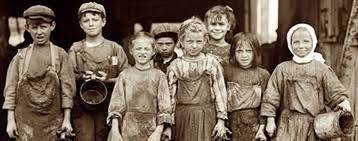
Child workers dress main qimg e4e37ced571a198b0ed1e0b57e6a0796 c
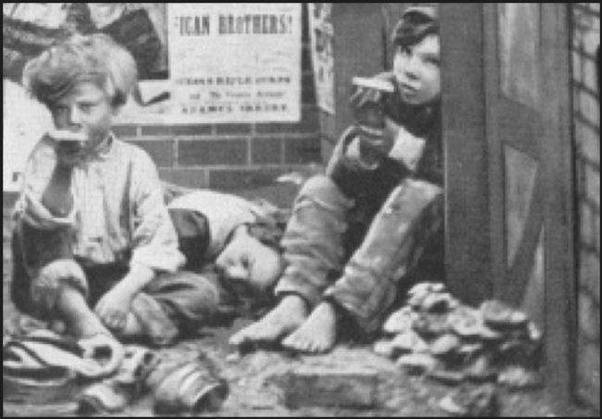
Children in corner Katherine Bailey PhD Victorian Era Media Studies main qimg 8afec4

poorer class dress main qimg cbe4847b8a1dcdae9bf83f9d1505cee6 c
Three street children Katherine Bailey PhD Victorian Era Media Studies main qimg 37c43fdabd3e917b651e7c76c4a7817b c

Photograph showing a Victorian family at work making trousers Image courtesy of www.eriding.net poorclothessml
Thanks.
The members and their visitors thank the speaker for her most interesting talk, which took us through a very rapid time of social change reflected in the clothes of people
and changing methods of manufacture.
Some Links for Further Study.
https://www.historic-uk.com/CultureUK/Victorian-Fashion
https://www.fashion-era.com/mid-late_victorian_fashion.htm
http://www.vam.ac.uk/content/articles/h/history-of-fashion-1840-1900/
http://www.victorianweb.org/victorian/art/costume/index.html
http://www.victoriana.com/Fashion/1850sfashion/victorianfashionhistory1850.htm
https://www.fashion-era.com/the_victorian_era.htm
https://en.wikipedia.org/wiki/Victorian_fashion
https://commons.wikimedia.org/wiki/Category:Victorian_fashion
https://en.wikipedia.org/wiki/Fashion_plate
http://victorian-era.org/victorian-era-morality.html
https://www.historicalemporium.com/mens-late-victorian-clothing.php
https://www.historicalemporium.com/how-to-guides.php#fashion
https://www.historyextra.com/period/victorian/stitching-the-fashions-of-the-19th-century
http://www.victorianlondon.org/clothing/secondhand.htm
http://www.victorianlondon.org/professions/secondhandclothes.htm
https://www.youtube.com/watch?v=IS10gTJfnPk
A video on hand stiching of clothes before mass manufacture.
Victorian Hand-Sewing: The Sew and Fell Stitch.
https://www.eastlondonhistory.co.uk/history-petticoat-lane-market
https://www.dbeinla.org/history-of-petticoat-lane
https://www.quora.com/What-clothes-did-poor-Victorians-wear
https://community.dur.ac.uk/4schools.resources/victoriandurham/home8.html
http://www.primaryhomeworkhelp.co.uk/victorians/clothes/buying.html
https://fashionfromthevictorianera.weebly.com/who-wore-what.html
https://en.wikipedia.org/wiki/Crinoline
Poor clothes exQuora main qimg 8afec442d44416c74e876e1844b9adf7 c


